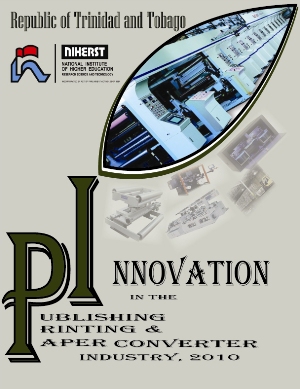
The National Institute of Higher Education, Research, Science and Technology (NIHERST) conducted a survey of innovation in the publishing, printing and paper converter industry during the period June/July 2010.
The results of the survey should provide insights into the innovation process and assist decision makers in developing policies to create the environment and incentives to catalyse innovation in the industry.
Summary of Main Findings
Innovation Activities
- None of the 37 establishments that participated in the survey had a licensing contract for product or process technology.
- A significant percentage (81%) of the respondents, especially in publishing (100%) and printing (83%), indicated that they were not sub-contracting for another establishment while two-thirds (67%) in paper converting were engaged in such activity.
- Three-quarters (76%) of the respondents indicated that they were not outsourcing while one-quarter (24%) stated that they were. The highest percentage of outsourcing was observed amongst the paper converters (33%) and printers (27%).
- Overall, over a half (57%) of the establishments, ranging from 50 - 67% of the sub-sectors, reported the purchase of new machinery and equipment during the period 2008 -2009, mainly from foreign markets (86%).
- Product innovation constituted mainly the improvement of an existing product and to a lesser extent, the introduction of a new product. Over a half of the establishments (54%) indicated that they had improved an existing product while 35% and 14% introduced and developed new products respectively.
- Technological process innovation centered on the improvement of existing processes (51%) and the introduction of new processes (43%).
- Forty percent (40%) or more of the respondents were engaged in various types of organisational innovation.
- Marketing innovation included the implementation of marketing methods and the development of new markets at home and abroad. Thirty-eight percent (38%) of the establishments stated that they had introduced new marketing techniques, while 32% and 14% developed new markets at home and abroad respectively.
Driving Forces and Obstacles to Innovation
- A half of the respondents rated improving productivity (51%) and customer satisfaction (51%), and reducing production costs (49%) as very important reasons for innovating. Improving product quality (43%), complying with local laws or standards (38%), and increasing market share (35%) were also identified as very important. The lowest rating was assigned to dealing with new competitors abroad, in that a quarter (24%) of respondents indicated that it was not important.
- Manpower and financing were cited as major obstacles to innovation. The high cost of the innovation project (32%), lack of skilled/qualified personnel (32%), and the lack of financing (30%) were identified as very significant obstacles to innovation, as well as domestic economic conditions (27%). A substantial percentage of the respondents indicated that lack of information on technology itself (73%), long administrative/ approval process within the firm (65%), legislation (65%), and the lack of information on markets (62%) were not relevant/appropriate. A half (51%) expressed a similar view with regards to the lack of marketing capability and the lack of external technical support.
Linkages and Collaboration
- The majority of respondents identified customers (51%), suppliers (43%) and their establishments (41%) as very important sources of information. Parent firms (46%), client firms (46%), consultancy firms (43%), and government or public research institutes (38%) were not used as sources of information for innovation. Personal journals and trade publications, and education and research institutes were considered mainly moderately important sources of information by 35% and 30% of the respondents respectively.
- Customers (46%) were identified as the major source of product related information followed by personal journals and trade publications (32%). Process related information emanated mainly from within the establishment (51%) and suppliers of equipment, material and components or software (41%). With respect to marketing related information, fairs, exhibitions and conferences were used by 30% of the respondents while the majority of establishments did not access management related information from the sources as stated.
- In general, most establishments in the industry were not engaged in co-operative and collaborative arrangements as a means of diffusion. A quarter of the establishments had co-operative and collaborative arrangements with customers (27%) and suppliers (24%) while one-fifth (19%) had such arrangements with competitors. Thirty percent (30%) of the respondents cited accessing new markets as a reason for collaboration.
Impact of Innovation on Key Performance Indicators
- A substantial percentage of respondents indicated that innovation resulted in increased service quality (62%), productivity (51%), competitiveness (51%), and profitability (46%). Two-fifths of the establishments recorded growth in product differentiation (41%), market share (38%), and diversification (38%). Thirty-five (35%) of respondents reported that innovation had a positive environmental impact. The survey results also indicate some negative impact of innovation on employment (24%) and cash flow (19%).
Research and Development
- Twenty-two percent (22%) of establishments stated that they had undertaken research and development activities while 54% responded negatively. Four (11%) establishments utilised copyrights to protect their intellectual property, while three (8%) utilised trademarks, two (5%) confidentiality agreements, and one (3%) establishment in each case of patents and trade secrets.
Information and Communication Technology (ICT)
- The vast majority (92%) of respondents, including all sub-sectors, utilised the Internet. Usage consisted of email (92%), searches on the World Wide Web (84%), advertising through a home page (57%), and e-commerce (51%).






